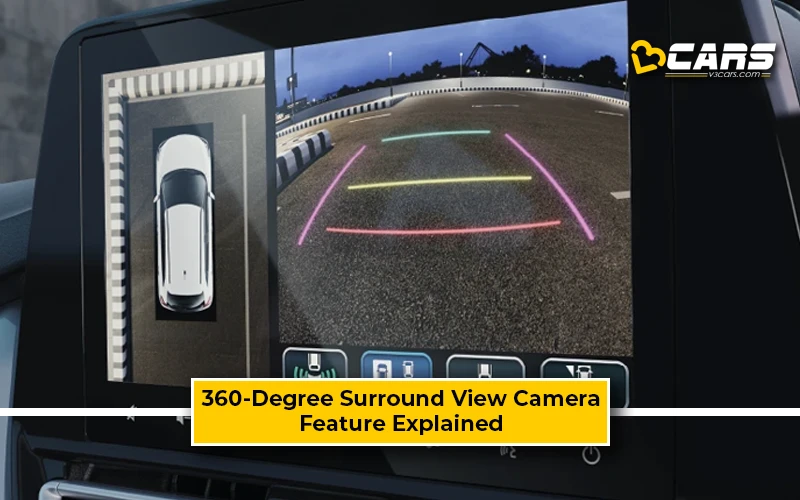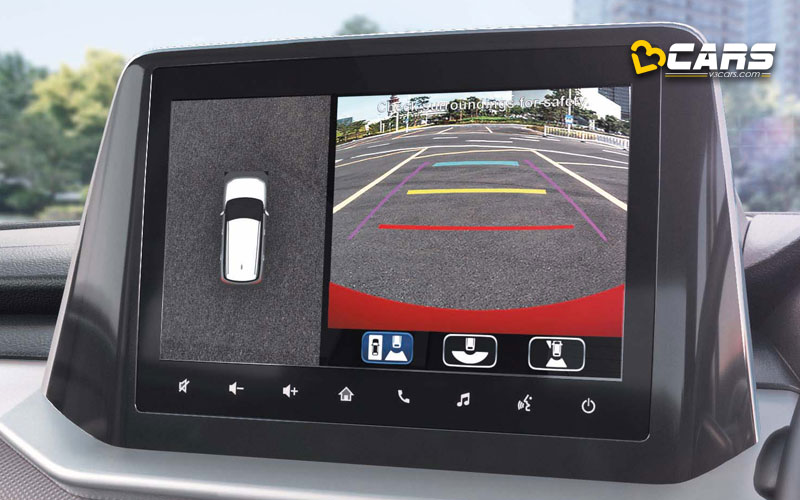360-Degree Surround View Camera – Feature Explained
In this feature explained article, we’ll explain how the 360-degree surround view cameras in cars work. We’ll also look at the pros and cons of a 360-degree surround view camera and the typical cost of getting this feature installed from the aftermarket. Based on this analysis, we’ll suggest if you should add this feature to your car or skip it.

What Is A 360-Degree Surround View Camera?
A 360-degree surround view camera, which is also known as around-view camera or top-down camera, is a feature in modern cars that provides a real-time bird’s eye view of your car’s surroundings. This feature helps manoeuvring your car into tight parking spots with complete confidence as it gives you a view of obstacles around you. Thus, a 360-degree camera or around-view camera eliminates guesswork and anxiety while parking a car.
How Does A 360-Degree Surround View Camera Work?
The 360-degree surround view camera feature in your car uses a blend of hardware and software to provide a visual representation of your car’s surroundings. The entire system comprises the following components:
- Fisheye Cameras: Typically, four wide-angle fisheye cameras are strategically placed around the car. One camera is on the front grille, another on the rear hatch, and one under each side outside rearview mirror (ORVM). These specialised lenses capture a much wider field of view than standard cameras.
- Image Processing Unit: The captured images from all 4 cameras are sent to a central processing unit. This powerhouse stitches these images together, transforming the fisheye views into a seamless, undistorted overhead or "bird's-eye" view of your car's surroundings.
- Display Integration: The processed image is then displayed on the car's infotainment screen, providing the driver with a real-time, 360-degree view of the vehicle and its surroundings. Some systems offer additional split-screen views with close-up visuals from specific cameras for a more detailed look.
Also Read: Cars In India Under Rs. 15.0 Lakh With 360-Degree Camera
What Are The Pros And Cons Of 360-Degree Surround View Camera?
Pros Or Advantages Of A 360-Degree Surround View Camera
The 360-degree surround view camera offers several advantages for drivers:
- Enhanced Parking Precision: The overhead view eliminates blind spots and provides a clear picture of your car's position relative to parking lines, curbs, and other vehicles. This significantly reduces the risk of parking mishaps, especially in tight spaces.
- Improved Manoeuvring at Low Speeds: Navigating narrow streets, driveways, or crowded parking lots becomes less stressful with the 360-degree view. You can see exactly how close you are to obstacles on all sides of your car.
- Reduced Risk of Curb Your Wheels And Side Sills: The system helps you avoid those dreaded scrapes against curbs by highlighting your car's proximity to them.
- Increased Safety Awareness: The 360-degree view can be particularly helpful when backing out of driveways or parking spots onto busy streets. You can see approaching vehicles or pedestrians that might be hidden from your usual vantage point.
Cons Or Drawbacks Of A 360-Degree Surround View Camera
While a 360-degree surround view camera system is undoubtedly beneficial, there are a few limitations to consider:
- System Reliance: Overdependence on the camera system can hinder the development of good spatial awareness and parking skills. It's always important to practise safe driving habits and rely on a combination of visual cues and blind spot checks.
- Limited View in Poor Conditions: The camera system's effectiveness can be hampered by rain, snow, or dirt on the lenses, which can obscure the view.
- Cost Factor: 360-degree surround view cameras are typically found in higher variants, potentially increasing the car's initial cost.
Is It Possible To Add A 360-Degree Surround View Camera From The Aftermarket?
Adding a 360-degree surround view camera system to an existing car is possible, but it can be complex and expensive compared to other aftermarket features. Here's a breakdown of the feasibility:
Challenges Of Adding An Aftermarket 360-Degree Camera System:
- Professional Installation: The system requires proper installation of 4 fisheye cameras, typically one on either ORVMs, one on the front grille, and one on the rear hatch. Running wires from these cameras to a central processing unit and integrating the system with the car's infotainment system can be challenging and requires a certain level of expertise in auto electronics. Attempting a DIY installation might risk improper functioning or electrical issues.
- Compatibility: Ensuring compatibility between the aftermarket camera system and your specific car model is crucial. Not all aftermarket systems are universally compatible, and some car models might have specific requirements for integrating new features.
Cost Considerations:
- Camera System: Aftermarket 360-degree camera system kits can range in price depending on quality and features. A basic system might start around ₹15,000, while more advanced systems with high-resolution cameras and night vision capabilities can cost significantly more.
- Professional Installation: Labour costs for professional installation can vary depending on your location and the complexity of the system. Expect to pay several thousand rupees for professional service to ensure proper functioning.
Alternatives to Consider:
- Parking Sensors: While not offering a full 360-degree view, parking sensors at the front and rear of your car can provide audible warnings for obstacles behind and in front of your car, aiding in parking manoeuvres. These are generally easier to install and less expensive than a complete camera system. Find out how front and rear parking sensors work by clicking the links below:
Front Parking Sensors – Feature Explained
Rear Parking Sensors – Feature Explained
- Backup Camera: A rearview backup camera offers a more limited perspective but can be a valuable addition for improved visibility when reversing. These are generally more affordable and easier to install than a full 360-degree system. Find out how the rear parking camera works and the typical cost of getting this feature from the aftermarket by clicking the link below:
Rear Parking Camera – Feature Explained
Overall, adding a 360-degree surround view camera system to your car is possible, but it's a complex and potentially expensive endeavour. Carefully weigh the cost, complexity of installation, and potential benefits against alternative solutions like parking sensors or a backup camera before making a decision.
Is A 360-Degree Surround View Camera Worth It?
For drivers who frequently navigate tight parking spaces, value enhanced safety features, or simply desire a more stress-free parking experience, a 360-degree surround view camera can be a worthwhile investment. While not a replacement for good driving habits, it offers a valuable tool that can significantly improve parking precision and overall awareness on the road.
Note: Check your Car EMI with our - Car Loan EMI Calculator
You can use our Fuel Cost Calculator to see how much any petrol, diesel or CNG car will cost to run based on the latest fuel price in your city.



0 Comments